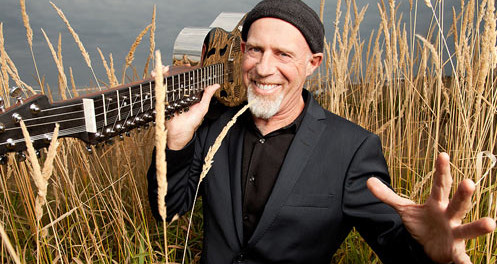Harry Manx: East meets West through a 20-string slide guitar
Who would think that blues and Indian classical music would be natural bedfellows? Harry Manx, that’s who. For over a decade, this ex-busker and one-time blues club soundman has been bringing the two together, with award-winning and breathtaking musical results. I had the opportunity to talk to Harry over a grilled cheese ahead of his one-man show at the Gésu.
Nancy Berman (NB): I was a little skeptical at first about bringing together blues and Indian classical music, such disparate traditions, but in your music it sounds totally natural. How do you make it work?
Harry Manx (HM): If you have enough imagination you can find a way to bring them together. It takes a little compromise. I bend the rules. But you have to know the rules before you start bending them! I know the Indian ragas. In blues there are rules too, but they’re not about how to play. The only rule in blues is that you have to feel what you’re playing; you must have feeling in your playing.
NB: How did you originally come up with the idea of bringing the blues and Indian music together?
HM: I’ve always loved to play the blues. I worked at the El Mocambo [a blues and rock venue] in Toronto when I was younger. I loved blues. Later in life I learned about Indian music. They started to get mixed up in my head. My blues became Indian blues. It happened like that. I couldn’t have planned it. I was happy it found some acceptance, this style of music — you never know. I feel very fortunate that people enjoy what I’m doing.
NB: It seems to me that there are some musical affinities between the two styles, like bent or “blue” notes.
HM: What I’m doing has some basis in the Indian style. I take the gats (the melodies of the ragas, or Indian scales), and I use them in songs. I mix them with Western songs. The bent notes are so important: in blues you can identify the musician by how he bends the note, like B.B. King, for example. And in Indian music it’s all about how you approach the note, from which direction, and all the passing notes in between.
NB: How did you find Vishwa Mohan Bhatt, your Indian music teacher?
HM: I was always going to India. But I also often went to Japan to busk — sometimes I made $1000 a day busking in Japan! Once I was playing in a shopping center, and I heard this music coming out of a store. I was captivated, and went in to ask what the music was, and it was Vishwa. So the next time I went to India I looked for him, and, through a musician friend of a friend I found someone who knew him. He was 2000 kilometres away from where I was, so it took me a few days to reach him, but once I did I spent five years studying with him. When I heard that 20-string guitar I knew right away that I was home.
I spent 12 years in India, studying with him and also studying sitar with another teacher. The instrument you study is secondary: first you learn the music, the structures of the songs, then you apply it to an instrument. I’m not a great player of Indian music — here in the west I might sound good, but I’m not. I take the flavour of Indian music and inject it into my music. But it’s best to start when you’re a child, then it’s in your blood.
NB: Was there a spiritual aspect to your interest in Indian music?
HM: Definitely. Since I was a teenager I’ve been interested in meditation. I first went to India in 1979, and I stayed in an ashram and meditated. That’s part of what drew me back there. The music deepens the silence. Music became my meditation. I’m still on that journey, on the constant search for more awareness, more consciousness. It definitely informs my music — nothing else is worth talking about. It’s a joy to close your eyes. I travel across the country and one thing I’ve learned is that solitude is your best companion. For an artist a lot goes on when you’re in tune with your inner reality, and that’s where I bring my music from. Solitude is the time to be creative.
NB: Tell me about your new album, “20 Strings and the Truth.”
HM: This one is probably more instrumental than my others. I didn’t write any words for it, which is unusual (the two tracks with lyrics are covers). But I wanted to make each piece like a little soundtrack, a little journey. Each has its own mood, its own raga. I wanted to make a CD you could put on and listen to while you do other things. But you can listen deeper too.
Harry Manx plays at the Gésu (1202 Bleury) as part of Montréal en Lumière, on February 26 2015 at 8pm. Tickets $40. Sold out.






